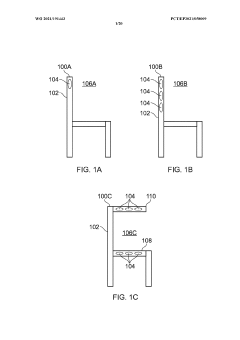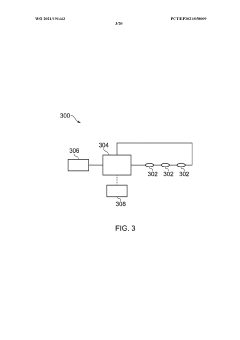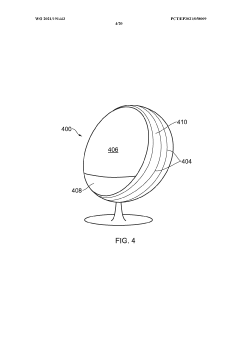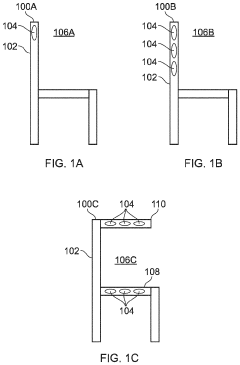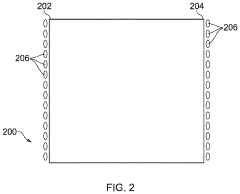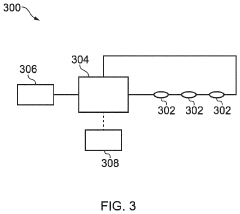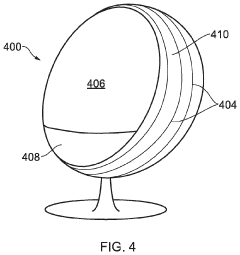Schumann Resonance’s Role in Climatic Anomalies
JUN 24, 20259 MIN READ
Generate Your Research Report Instantly with AI Agent
Patsnap Eureka helps you evaluate technical feasibility & market potential.
Schumann Resonance and Climate Anomalies: Background
The Schumann resonance, discovered by physicist Winfried Otto Schumann in 1952, is a set of spectrum peaks in the extremely low frequency (ELF) portion of the Earth's electromagnetic field spectrum. These resonances occur between the Earth's surface and the ionosphere, creating a global electromagnetic resonance phenomenon. The fundamental frequency of this resonance is approximately 7.83 Hz, with harmonics at higher frequencies.
Initially, the Schumann resonance was primarily of interest to researchers in the fields of atmospheric science and radio communications. However, in recent decades, its potential connection to climate anomalies has garnered increasing attention from the scientific community. This growing interest stems from the complex interplay between the Earth's electromagnetic environment and various atmospheric processes.
The Earth's climate system is intricate and influenced by numerous factors, including solar radiation, atmospheric composition, ocean currents, and land surface characteristics. The potential role of the Schumann resonance in this system adds another layer of complexity to our understanding of climate dynamics. Some researchers hypothesize that variations in the Schumann resonance may be linked to changes in global temperature patterns, extreme weather events, and other climatic anomalies.
One of the key aspects of this research is the exploration of how the Schumann resonance might interact with other atmospheric phenomena. For instance, some studies have investigated potential correlations between Schumann resonance variations and the El Niño-Southern Oscillation (ENSO), a major driver of global climate variability. Others have examined possible links between Schumann resonance characteristics and lightning activity, which is closely tied to atmospheric convection and energy transfer processes.
The investigation into the Schumann resonance's role in climatic anomalies also intersects with broader research on the Earth's magnetic field and its influence on climate. This includes studies on how changes in the geomagnetic field might affect atmospheric circulation patterns and energy distribution in the Earth system. Such research contributes to our evolving understanding of the complex feedback mechanisms within the Earth's climate system.
As climate change continues to be a pressing global concern, understanding all potential factors influencing climate variability becomes increasingly crucial. The study of the Schumann resonance in relation to climatic anomalies represents an interdisciplinary effort, combining knowledge from atmospheric physics, electromagnetic theory, climatology, and Earth system science. This research not only advances our fundamental understanding of Earth's electromagnetic environment but also potentially offers new insights into climate prediction and modeling.
Initially, the Schumann resonance was primarily of interest to researchers in the fields of atmospheric science and radio communications. However, in recent decades, its potential connection to climate anomalies has garnered increasing attention from the scientific community. This growing interest stems from the complex interplay between the Earth's electromagnetic environment and various atmospheric processes.
The Earth's climate system is intricate and influenced by numerous factors, including solar radiation, atmospheric composition, ocean currents, and land surface characteristics. The potential role of the Schumann resonance in this system adds another layer of complexity to our understanding of climate dynamics. Some researchers hypothesize that variations in the Schumann resonance may be linked to changes in global temperature patterns, extreme weather events, and other climatic anomalies.
One of the key aspects of this research is the exploration of how the Schumann resonance might interact with other atmospheric phenomena. For instance, some studies have investigated potential correlations between Schumann resonance variations and the El Niño-Southern Oscillation (ENSO), a major driver of global climate variability. Others have examined possible links between Schumann resonance characteristics and lightning activity, which is closely tied to atmospheric convection and energy transfer processes.
The investigation into the Schumann resonance's role in climatic anomalies also intersects with broader research on the Earth's magnetic field and its influence on climate. This includes studies on how changes in the geomagnetic field might affect atmospheric circulation patterns and energy distribution in the Earth system. Such research contributes to our evolving understanding of the complex feedback mechanisms within the Earth's climate system.
As climate change continues to be a pressing global concern, understanding all potential factors influencing climate variability becomes increasingly crucial. The study of the Schumann resonance in relation to climatic anomalies represents an interdisciplinary effort, combining knowledge from atmospheric physics, electromagnetic theory, climatology, and Earth system science. This research not only advances our fundamental understanding of Earth's electromagnetic environment but also potentially offers new insights into climate prediction and modeling.
Market Demand for Climate Prediction Tools
The market demand for climate prediction tools has been steadily increasing in recent years, driven by the growing awareness of climate change impacts and the need for accurate forecasting in various sectors. Climate prediction tools that incorporate Schumann Resonance data offer a unique value proposition in this expanding market.
The agriculture sector represents a significant portion of the demand for climate prediction tools. Farmers and agribusinesses rely on accurate climate forecasts to make critical decisions about planting, harvesting, and resource allocation. The potential integration of Schumann Resonance data into climate models could provide more precise predictions of extreme weather events and long-term climate trends, enabling better risk management and crop yield optimization.
Insurance companies are another key market segment showing increased interest in advanced climate prediction tools. As climate-related risks continue to rise, insurers are seeking more sophisticated methods to assess and price these risks accurately. Tools that can leverage Schumann Resonance data to improve the prediction of severe weather events and climatic anomalies could help insurers develop more accurate risk models and tailor their products accordingly.
The energy sector, particularly renewable energy providers, has a growing need for precise climate prediction tools. Wind and solar energy generation are highly dependent on weather conditions, and improved forecasting can lead to more efficient energy production and distribution. Climate prediction tools incorporating Schumann Resonance data could potentially offer more accurate long-term climate projections, aiding in strategic planning for renewable energy infrastructure.
Government agencies and disaster management organizations are also significant consumers of climate prediction tools. The ability to forecast extreme weather events and long-term climate trends is crucial for disaster preparedness and mitigation strategies. Enhanced prediction capabilities through the integration of Schumann Resonance data could lead to more effective early warning systems and improved resource allocation for disaster response.
The tourism industry is increasingly affected by climate variability and is showing growing interest in climate prediction tools. Tour operators, hotels, and destination management companies rely on accurate climate forecasts to plan seasonal activities and manage visitor expectations. Tools that can provide more reliable long-term climate projections could help the industry adapt to changing climate patterns and develop sustainable tourism strategies.
As climate change continues to impact global ecosystems, conservation organizations and environmental agencies are seeking advanced prediction tools to monitor and protect vulnerable habitats. The potential of Schumann Resonance-based climate prediction tools to provide insights into subtle environmental changes could be particularly valuable for biodiversity conservation efforts and ecosystem management.
The agriculture sector represents a significant portion of the demand for climate prediction tools. Farmers and agribusinesses rely on accurate climate forecasts to make critical decisions about planting, harvesting, and resource allocation. The potential integration of Schumann Resonance data into climate models could provide more precise predictions of extreme weather events and long-term climate trends, enabling better risk management and crop yield optimization.
Insurance companies are another key market segment showing increased interest in advanced climate prediction tools. As climate-related risks continue to rise, insurers are seeking more sophisticated methods to assess and price these risks accurately. Tools that can leverage Schumann Resonance data to improve the prediction of severe weather events and climatic anomalies could help insurers develop more accurate risk models and tailor their products accordingly.
The energy sector, particularly renewable energy providers, has a growing need for precise climate prediction tools. Wind and solar energy generation are highly dependent on weather conditions, and improved forecasting can lead to more efficient energy production and distribution. Climate prediction tools incorporating Schumann Resonance data could potentially offer more accurate long-term climate projections, aiding in strategic planning for renewable energy infrastructure.
Government agencies and disaster management organizations are also significant consumers of climate prediction tools. The ability to forecast extreme weather events and long-term climate trends is crucial for disaster preparedness and mitigation strategies. Enhanced prediction capabilities through the integration of Schumann Resonance data could lead to more effective early warning systems and improved resource allocation for disaster response.
The tourism industry is increasingly affected by climate variability and is showing growing interest in climate prediction tools. Tour operators, hotels, and destination management companies rely on accurate climate forecasts to plan seasonal activities and manage visitor expectations. Tools that can provide more reliable long-term climate projections could help the industry adapt to changing climate patterns and develop sustainable tourism strategies.
As climate change continues to impact global ecosystems, conservation organizations and environmental agencies are seeking advanced prediction tools to monitor and protect vulnerable habitats. The potential of Schumann Resonance-based climate prediction tools to provide insights into subtle environmental changes could be particularly valuable for biodiversity conservation efforts and ecosystem management.
Current Understanding and Challenges
The current understanding of Schumann Resonance's role in climatic anomalies is still in its early stages, with ongoing research and debates within the scientific community. Schumann Resonances, discovered by Winfried Otto Schumann in 1952, are global electromagnetic resonances generated and excited by lightning discharges in the cavity formed by the Earth's surface and the ionosphere.
Recent studies have suggested potential links between Schumann Resonances and various climatic phenomena, including temperature fluctuations, precipitation patterns, and extreme weather events. However, the exact mechanisms and extent of these relationships remain unclear, presenting significant challenges for researchers in this field.
One of the primary challenges in studying Schumann Resonance's impact on climate is the complexity of the Earth's electromagnetic environment. The resonances are influenced by numerous factors, including solar activity, geomagnetic storms, and human-induced electromagnetic noise, making it difficult to isolate their specific effects on climatic systems.
Additionally, the global nature of Schumann Resonances poses challenges in data collection and analysis. Researchers must rely on a network of monitoring stations worldwide to gather comprehensive data, which can be costly and logistically challenging to maintain.
Another significant hurdle is the interdisciplinary nature of this research. It requires expertise from various fields, including atmospheric physics, electromagnetic theory, climatology, and data science. Integrating knowledge from these diverse disciplines to form a cohesive understanding of Schumann Resonance's role in climate anomalies is a complex task.
The lack of long-term, high-resolution data on Schumann Resonances and their potential correlations with climatic variables also hinders progress in this area. While some historical data exists, it is often insufficient for drawing definitive conclusions about long-term trends and relationships.
Furthermore, the scientific community faces challenges in developing accurate models that can simulate the interactions between Schumann Resonances and climatic systems. The multifaceted nature of these interactions, coupled with the Earth's complex atmospheric dynamics, makes it difficult to create comprehensive and reliable predictive models.
Despite these challenges, ongoing research continues to shed light on the potential connections between Schumann Resonances and climatic anomalies. Advanced monitoring technologies, improved data analysis techniques, and interdisciplinary collaborations are gradually enhancing our understanding of this intriguing phenomenon and its possible implications for global climate patterns.
Recent studies have suggested potential links between Schumann Resonances and various climatic phenomena, including temperature fluctuations, precipitation patterns, and extreme weather events. However, the exact mechanisms and extent of these relationships remain unclear, presenting significant challenges for researchers in this field.
One of the primary challenges in studying Schumann Resonance's impact on climate is the complexity of the Earth's electromagnetic environment. The resonances are influenced by numerous factors, including solar activity, geomagnetic storms, and human-induced electromagnetic noise, making it difficult to isolate their specific effects on climatic systems.
Additionally, the global nature of Schumann Resonances poses challenges in data collection and analysis. Researchers must rely on a network of monitoring stations worldwide to gather comprehensive data, which can be costly and logistically challenging to maintain.
Another significant hurdle is the interdisciplinary nature of this research. It requires expertise from various fields, including atmospheric physics, electromagnetic theory, climatology, and data science. Integrating knowledge from these diverse disciplines to form a cohesive understanding of Schumann Resonance's role in climate anomalies is a complex task.
The lack of long-term, high-resolution data on Schumann Resonances and their potential correlations with climatic variables also hinders progress in this area. While some historical data exists, it is often insufficient for drawing definitive conclusions about long-term trends and relationships.
Furthermore, the scientific community faces challenges in developing accurate models that can simulate the interactions between Schumann Resonances and climatic systems. The multifaceted nature of these interactions, coupled with the Earth's complex atmospheric dynamics, makes it difficult to create comprehensive and reliable predictive models.
Despite these challenges, ongoing research continues to shed light on the potential connections between Schumann Resonances and climatic anomalies. Advanced monitoring technologies, improved data analysis techniques, and interdisciplinary collaborations are gradually enhancing our understanding of this intriguing phenomenon and its possible implications for global climate patterns.
Existing Methods for Studying SR-Climate Links
01 Monitoring and analyzing Schumann resonance for climate anomalies
Systems and methods for monitoring Schumann resonance to detect and analyze climatic anomalies. These systems use sensors to measure electromagnetic signals in the Earth's atmosphere, which can be correlated with various weather patterns and climate changes. The data collected can be used to predict and understand climate-related phenomena.- Monitoring and analyzing Schumann resonance for climate anomalies: Systems and methods for monitoring Schumann resonance to detect and analyze climatic anomalies. These systems use sensors to measure electromagnetic signals in the Earth's atmosphere, which can be correlated with various climate phenomena and used to predict weather patterns or environmental changes.
- Devices for generating and manipulating Schumann resonance: Inventions related to devices that can generate or manipulate Schumann resonance frequencies. These devices may be used for various purposes, including climate modification, weather control, or environmental research. They often involve complex electromagnetic systems and may have applications in both scientific and practical fields.
- Schumann resonance in health and wellness applications: Utilization of Schumann resonance in health and wellness products or therapies. This includes devices that simulate or enhance natural Schumann resonance frequencies, potentially offering benefits such as stress reduction, improved sleep, or overall well-being. These applications often link the Earth's natural electromagnetic field to human health.
- Integration of Schumann resonance in environmental monitoring systems: Development of environmental monitoring systems that incorporate Schumann resonance measurements. These systems may be used to detect various environmental changes, including potential climatic anomalies, by analyzing variations in the Earth's electromagnetic field. They often combine multiple sensors and data analysis techniques for comprehensive environmental assessment.
- Schumann resonance in atmospheric and space weather research: Research and technologies focusing on the relationship between Schumann resonance and atmospheric or space weather phenomena. This includes studies on how solar activity, ionospheric changes, and other space weather events might influence Schumann resonance, and how these interactions could be linked to climatic anomalies on Earth.
02 Devices for generating and manipulating Schumann resonance
Inventions related to devices that can generate or manipulate Schumann resonance frequencies. These devices may be used for various purposes, including climate modification, weather control, or environmental research. Some designs incorporate resonant cavities or specialized antennas to interact with the Earth's electromagnetic field.Expand Specific Solutions03 Schumann resonance in relation to atmospheric ionization
Research and technologies focusing on the relationship between Schumann resonance and atmospheric ionization. This includes studies on how changes in ionization levels, potentially caused by cosmic rays or other factors, can affect Schumann resonance frequencies and potentially influence climate patterns.Expand Specific Solutions04 Applications of Schumann resonance in climate prediction models
Integration of Schumann resonance data into climate prediction models and weather forecasting systems. These applications aim to improve the accuracy of long-term climate projections and short-term weather forecasts by incorporating electromagnetic data from the Earth's atmosphere.Expand Specific Solutions05 Schumann resonance anomalies and their correlation with extreme weather events
Studies and systems designed to investigate the correlation between anomalies in Schumann resonance frequencies and the occurrence of extreme weather events. This research aims to establish potential early warning systems for natural disasters or significant climate shifts based on changes in the Earth's electromagnetic field.Expand Specific Solutions
Key Players in Climate and Geophysics Research
The research on Schumann Resonance's role in climatic anomalies is in an emerging stage, with a growing market as climate change concerns intensify. The technology's maturity is still developing, with various institutions contributing to its advancement. Universities like Nanjing University, Lanzhou University, and the University of Bern are at the forefront of academic research. Research institutes such as the China Institute of Water Resources & Hydropower Research and the China Institute of Meteorology are also key players. Companies like Schlumberger and its subsidiaries are involved, potentially applying this research to their geophysical services. The diverse range of participants, from academic to industrial sectors, indicates a multidisciplinary approach to understanding this complex phenomenon and its potential impact on climate.
China Institute of Water Resources & Hydropower Research
Technical Solution: The institute has developed a comprehensive monitoring system for Schumann resonances (SR) and their potential impact on climate anomalies. Their approach involves a network of SR monitoring stations across China, coupled with advanced data analysis techniques. They use machine learning algorithms to correlate SR data with various climatic parameters, including temperature, precipitation, and extreme weather events. The institute has also developed models to simulate the interaction between SR and the ionosphere, providing insights into how these resonances might influence atmospheric dynamics and climate patterns.
Strengths: Extensive monitoring network, advanced data analysis capabilities, and interdisciplinary approach. Weaknesses: Limited global coverage, potential bias towards regional climate effects.
University of Bern
Technical Solution: The University of Bern has developed a novel approach to studying the role of Schumann resonances in climate anomalies. Their research focuses on the potential link between SR and the Earth's carbon cycle, particularly how SR might influence atmospheric CO2 concentrations. They have established a unique experimental setup that combines SR measurements with high-precision greenhouse gas monitoring. Using advanced statistical methods and machine learning algorithms, they analyze long-term datasets to identify potential correlations between SR variations and changes in atmospheric composition. The university also collaborates with climate modelers to incorporate SR effects into global climate models, aiming to improve the accuracy of climate predictions.
Strengths: Innovative focus on SR-carbon cycle interactions, strong interdisciplinary collaboration, and integration of SR into climate models. Weaknesses: Complexity of isolating SR effects from other environmental factors, limited geographical scope of direct measurements.
Innovative Approaches in SR-Climate Research
A magnetic field exposure system and uses thereof
PatentWO2021191443A1
Innovation
- A magnetic field exposure system generating an amplitude-modulated low frequency magnetic field with a carrier frequency of 360 to 450 Hz and a modulation frequency of 0.5 to 100 Hz, with a field strength of 0.5 to 250 mT, specifically designed to expose organic cells or tissues to improve cell survival, proliferation, reduce stress, and enhance well-being.
A magnetic field exposure system and uses thereof
PatentPendingUS20230372726A1
Innovation
- A magnetic field exposure system generating an amplitude-modulated low frequency magnetic field with a carrier frequency of 360 to 450 Hz and a modulation frequency of 0.5 to 100 Hz, providing a field strength of 0.5 to 250 μT, specifically designed to enhance cell survival, proliferation, reduce stress, and promote tissue regeneration.
Environmental Policy Implications
The research on Schumann Resonance's role in climatic anomalies has significant implications for environmental policy. As our understanding of the complex interactions between the Earth's electromagnetic field and climate systems deepens, policymakers must consider these findings when formulating strategies to address climate change and environmental protection.
One key policy implication is the need for increased funding and support for research in this field. Given the potential impact of Schumann Resonance on climate patterns, governments and international organizations should prioritize allocating resources to further investigate this phenomenon. This could include establishing dedicated research centers, funding long-term monitoring programs, and promoting interdisciplinary collaboration between atmospheric scientists, geophysicists, and climate experts.
Environmental policies may need to be reevaluated in light of the potential influence of Schumann Resonance on climatic anomalies. For instance, current climate models and predictions may need to be adjusted to account for this additional factor, potentially altering our understanding of climate change trajectories and the effectiveness of existing mitigation strategies.
The findings from Schumann Resonance research could also impact policies related to electromagnetic pollution. If a strong link is established between human-induced electromagnetic disturbances and climate anomalies, policymakers may need to consider implementing stricter regulations on electromagnetic emissions from various sources, including telecommunications infrastructure and power grids.
Furthermore, the potential role of Schumann Resonance in climate systems underscores the importance of holistic approaches to environmental policy. Policymakers should consider adopting more integrated strategies that account for the interconnectedness of various Earth systems, including the atmosphere, ionosphere, and magnetosphere.
International cooperation in environmental policy may also be affected by these findings. As Schumann Resonance is a global phenomenon, addressing its potential impacts on climate would require coordinated efforts across nations. This could lead to new international agreements or the modification of existing ones, such as the Paris Agreement, to incorporate considerations related to Earth's electromagnetic field and its influence on climate.
Lastly, the research on Schumann Resonance and climatic anomalies highlights the need for adaptive environmental policies. As our understanding of these complex systems evolves, policymakers must be prepared to adjust strategies and regulations accordingly. This may involve developing more flexible policy frameworks that can readily incorporate new scientific findings and respond to emerging environmental challenges.
One key policy implication is the need for increased funding and support for research in this field. Given the potential impact of Schumann Resonance on climate patterns, governments and international organizations should prioritize allocating resources to further investigate this phenomenon. This could include establishing dedicated research centers, funding long-term monitoring programs, and promoting interdisciplinary collaboration between atmospheric scientists, geophysicists, and climate experts.
Environmental policies may need to be reevaluated in light of the potential influence of Schumann Resonance on climatic anomalies. For instance, current climate models and predictions may need to be adjusted to account for this additional factor, potentially altering our understanding of climate change trajectories and the effectiveness of existing mitigation strategies.
The findings from Schumann Resonance research could also impact policies related to electromagnetic pollution. If a strong link is established between human-induced electromagnetic disturbances and climate anomalies, policymakers may need to consider implementing stricter regulations on electromagnetic emissions from various sources, including telecommunications infrastructure and power grids.
Furthermore, the potential role of Schumann Resonance in climate systems underscores the importance of holistic approaches to environmental policy. Policymakers should consider adopting more integrated strategies that account for the interconnectedness of various Earth systems, including the atmosphere, ionosphere, and magnetosphere.
International cooperation in environmental policy may also be affected by these findings. As Schumann Resonance is a global phenomenon, addressing its potential impacts on climate would require coordinated efforts across nations. This could lead to new international agreements or the modification of existing ones, such as the Paris Agreement, to incorporate considerations related to Earth's electromagnetic field and its influence on climate.
Lastly, the research on Schumann Resonance and climatic anomalies highlights the need for adaptive environmental policies. As our understanding of these complex systems evolves, policymakers must be prepared to adjust strategies and regulations accordingly. This may involve developing more flexible policy frameworks that can readily incorporate new scientific findings and respond to emerging environmental challenges.
Interdisciplinary Collaboration Opportunities
The research on Schumann Resonance's role in climatic anomalies presents a unique opportunity for interdisciplinary collaboration across various scientific fields. This complex phenomenon requires expertise from multiple domains to fully understand its potential impact on climate systems and weather patterns.
Atmospheric scientists and meteorologists can contribute their knowledge of global atmospheric circulation patterns and climate modeling to investigate how Schumann Resonance might influence large-scale weather systems. Their expertise in data analysis and climate prediction models can help identify correlations between Schumann Resonance variations and climatic anomalies.
Geophysicists and Earth scientists play a crucial role in understanding the relationship between the Earth's electromagnetic field and the ionosphere, where Schumann Resonances occur. Their insights into the planet's internal structure and electromagnetic properties are essential for developing comprehensive models of Schumann Resonance behavior.
Electrical engineers and physicists specializing in electromagnetic theory can provide valuable input on the mechanisms of electromagnetic wave propagation and resonance in the Earth-ionosphere cavity. Their expertise is vital for developing accurate measurement techniques and interpreting Schumann Resonance data.
Biologists and environmental scientists can investigate the potential effects of Schumann Resonance on ecosystems and living organisms. This collaboration could shed light on how changes in the Earth's electromagnetic environment might impact biodiversity and ecological processes.
Computer scientists and data analysts are essential for processing and interpreting the vast amounts of data generated by Schumann Resonance monitoring networks. Their expertise in machine learning and big data analytics can help identify subtle patterns and correlations that may not be apparent through traditional analysis methods.
Climatologists and paleoclimatologists can provide historical context and long-term climate data to help understand how Schumann Resonance may have influenced climate patterns over geological timescales. This perspective is crucial for assessing the potential long-term impacts of Schumann Resonance on global climate systems.
Interdisciplinary collaboration in this field also extends to space weather experts, who can contribute knowledge on how solar activity and cosmic rays influence the Earth's ionosphere and, consequently, Schumann Resonance. This connection between space weather and terrestrial climate systems represents an exciting frontier in climate research.
By fostering collaboration among these diverse scientific disciplines, researchers can develop a more comprehensive understanding of Schumann Resonance's role in climatic anomalies. This interdisciplinary approach not only enhances the quality and depth of research but also opens up new avenues for innovative solutions to climate-related challenges.
Atmospheric scientists and meteorologists can contribute their knowledge of global atmospheric circulation patterns and climate modeling to investigate how Schumann Resonance might influence large-scale weather systems. Their expertise in data analysis and climate prediction models can help identify correlations between Schumann Resonance variations and climatic anomalies.
Geophysicists and Earth scientists play a crucial role in understanding the relationship between the Earth's electromagnetic field and the ionosphere, where Schumann Resonances occur. Their insights into the planet's internal structure and electromagnetic properties are essential for developing comprehensive models of Schumann Resonance behavior.
Electrical engineers and physicists specializing in electromagnetic theory can provide valuable input on the mechanisms of electromagnetic wave propagation and resonance in the Earth-ionosphere cavity. Their expertise is vital for developing accurate measurement techniques and interpreting Schumann Resonance data.
Biologists and environmental scientists can investigate the potential effects of Schumann Resonance on ecosystems and living organisms. This collaboration could shed light on how changes in the Earth's electromagnetic environment might impact biodiversity and ecological processes.
Computer scientists and data analysts are essential for processing and interpreting the vast amounts of data generated by Schumann Resonance monitoring networks. Their expertise in machine learning and big data analytics can help identify subtle patterns and correlations that may not be apparent through traditional analysis methods.
Climatologists and paleoclimatologists can provide historical context and long-term climate data to help understand how Schumann Resonance may have influenced climate patterns over geological timescales. This perspective is crucial for assessing the potential long-term impacts of Schumann Resonance on global climate systems.
Interdisciplinary collaboration in this field also extends to space weather experts, who can contribute knowledge on how solar activity and cosmic rays influence the Earth's ionosphere and, consequently, Schumann Resonance. This connection between space weather and terrestrial climate systems represents an exciting frontier in climate research.
By fostering collaboration among these diverse scientific disciplines, researchers can develop a more comprehensive understanding of Schumann Resonance's role in climatic anomalies. This interdisciplinary approach not only enhances the quality and depth of research but also opens up new avenues for innovative solutions to climate-related challenges.
Unlock deeper insights with Patsnap Eureka Quick Research — get a full tech report to explore trends and direct your research. Try now!
Generate Your Research Report Instantly with AI Agent
Supercharge your innovation with Patsnap Eureka AI Agent Platform!
